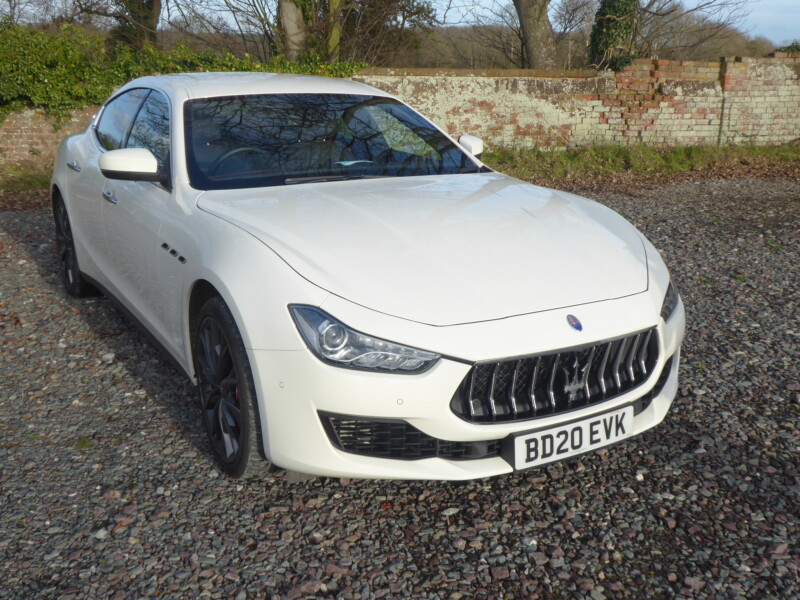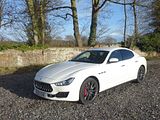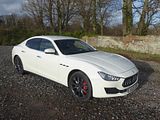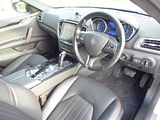The first Maserati made its debut in 1926. It was an out and out race car and everything that was produced by the firm for the next 21 years was similarly purposed. Finally, in 1947, the first road car was launched, the rather fabulous A6G 1500. For the next 15 years, Maserati built small volumes of exclusive machines which sported bodywork from a number of Italian coachbuilders. Needing to increase sales volume simply to stay in business, the company introduced their own factory bodywork with the 3500 GT Coupe of 1957 and although there were small numbers of coachbuilt cars created on this chassis, the future was clearly with the standard offering. Whilst the first models had all had two doors and limited or no space for rear passengers, Maserati made history in 1963 by launching a four door spacious four seater express, the Quattroporte. It had no direct rivals, and sales were steady for many years. Whilst there has not been a four door Maserati in the range on a completely continuous basis, there have now been six distinct generations of Quattroporte. The most recent, and still current car was made noticeably bigger than its predecessor, giving Maserati the opportunity to add a second saloon to their range, the Ghibli. The two cars were launched a matter of months apart, and at first glance look quite similar, though, with time and familiarity, most of us have learned how to tell them apart at a glance. With the Quattroporte having gone further upmarket, the Ghibli was given the task of trying to drive up sales volume and to persuade people to move away from the German executive car that they had probably been driving to this point. The idea that you could have something as exclusive as a Maserati, with all that wonderful heritage, for roughly the same price as a Mercedes CLS, Audi A7 or BMW 6 Gran Coupe looked, on paper, to be a winner. It certainly attracted me, and in 2016 I did indeed make the shift from a series of Audi models to a Maserati Ghibli. And I have no regrets.
At the time of the Ghibli’s launch, the majority of sales in the executive saloon car class were of diesel-powered models, so Maserati made sure they had one of those in the range, using a 3.0 litre diesel sourced from VM Motori, which meant that you could have a large saloon car that ticked the CO2 emissions and fuel economy boxes so necessary for the all-important company car market in the UK and the fiscal challenges elsewhere in Europe. But we all know that a Maserati should really have a petrol engine that goes well and makes a great noise. So whilst, the Diesel was the model that would achieve the majority of the sales, Maserati also offered the Ghibli with a 3.0 litre petrol V6, in two states of tune, the regular model with 345 bhp and the more potent S model with 424 bhp. In some markets the latter was offered with an optional four wheel drive system but the UK has always been denied this. I selected the diesel back in 2016 as I was driving around 25,000 miles a year and it made far more financial sense to go this route, but come the time of its replacement, the world had changed. Mileage had dropped right down, of course, during enforced lockdowns and I could see that when we did finally get free of these, it was likely that some of the lessons learned about remote working would remove a proportion of my business travel and hence my mileage. So whilst the Ghibli Hybrid, which arrived to take the place of the diesel model as part of the refresh for the 2021 model year still made a lot of sense, a part of me wondered about the V6 petrol car instead. Having sampled the Hybrid I needed to test the V6 model as well, to make the direct comparison, before signing on the proverbial dotted line. I arranged to borrow one the weekend after the Hybrid test.
The test car was a pre-facelift model, but having sampled, and already reviewed the 2021 model changes in the Ghibli Hybrid test, I could concentrate here on the differences that would come with the different engine. You are aware of them the moment you press the start button and fire the car up, as this one does sound different. No question, it sounds better, too. You’d hardly expect otherwise, as a 6 cylinder engine is always guaranteed to beat a 4 cylinder one. The four cylinder in the Hybrid had impressed me, but this one wow-ed me. There’s actually not that much difference in raw power, with 345 bhp vs 329 bhp, but it felt like there was a bit more than that on offer. This is a fabulous engine, which sounds amazing and which makes the Ghibli feel rapid. I can only imagine what the more potent cars, now including the V8 engined Trofeo, are like. Certainly I had to be careful when heading out on to the M42, with its speed cameras as the acceleration means that you are almost immediately travelling quite significantly faster than you realise. Like all Ghibli models, there is an 8 speed ZF automatic gearbox, and it is very smooth in its operation. The upper ratios are quite close together, so the transmission will find the optimum among them, with downshifts as you slow slightly, but you barely notice. The test car had the optional paddles if you want to change the gears yourself. I only drove the V6 model on a short test route so can’t really comment on the fuel economy, but I do know that this is the one thing which would counter-balance that extra urge and nicer noise. Whilst the diesel and, by all accounts, the hybrid model will readily deliver up to 40 mpg, sources tell me that this V6 will average nearer to 25 mpg, which is a big penalty. In all other respects, this Ghibli felt very similar to drive to the one I have owned for the past four years. The steering strikes the balance between weight and feel very well. This is a big and heavy car, but it really does not feel it, so the car is more nimble than you might expect, and, thanks to the near perfect weight distribution, it handles well, allowing for brisk progress on twisty roads. There is plenty of grip and very little body roll. The test car came on the optional 20” wheels, an inch up on those of my car. The ride did feel perhaps that bit firmer but this was definitely something I felt I could live with, and there are those who will prefer the bigger wheels on purely aesthetic grounds. The brakes are powerful and effective. Visibility whilst on the move is fine, with a good field of vision from the mirrors, but judging the front and back is hard, despite the presence of parking sensors. The rear-view camera which was fitted to this test car really is a useful addition, and well worth paying extra for.
The inside of this Ghibli was the same as the car as I have been driving for the past four years. There have been changes made since the initial launch cars of 2013, most noticeably in late 2016 when a new larger infotainment screen was fitted, which also necessitated revising the dual zone climate control switches that sit below it, and the transmission selector design was also altered in 2017 when the GranLusso and GranSport cars were introduced, but otherwise nothing of significance had changed until the most recent model refresh which alters instrument graphics and changes the infotainment screen yet again. Some cars will look different thanks to ticking the box for an all-leather dashboard. The electronic instrument dials are crisp and clear, with a blue tinge to the background as they light up. Large circular dials for speedo and rev counter are complemented by smaller bar chart style ones for water temperature and fuel level and there is a display area between them for the various trip computer and other information which you cycle through with buttons on the right hand steering spoke. The wheel also contains the cruise control, and there are audio repeater buttons on the rear of the wheel. There is a single column stalk, with wipers operated by twisting the end, something that does take a bit of getting used to. The centre of the dash is dominated b the infotainment system, which includes the audio and navigation functions. As well as the touch screen there are handy buttons in the central console which mean that it is easy to operate.
Large and comfortable front seats have a wide range of adjustment, although on the entry level spec this is not fully electric, so it is easy to get a good driving position. You can sit quite low, giving that sporty feel of sitting in the car rather than being perched on it, and combining this with a steering column which goes in/out and up/down, then getting things right for your proportions is easy. There is a wide centre console and it is set quite high, and I speak from experience that it is very difficult indeed to clamber from one side of the car to the other! There are three rear seat belts, but in reality this – like so many other large cars – is still really more of a four seater as there is a sizeable central tunnel and the centre console does come well back. Legroom is sufficient with the front seats set well back but perhaps not as a generous as you might be expecting given the size of the car. There are nets on the back of the front seats and small pockets on the doors for odds and ends and there is a drop-down armrest with cupholders in the upper surface. The boot is a good size. It is quite long from front to back, so reaching items that have gone right to the back is difficult. Inside the cabin there is a good-sized glovebox, some long but narrow door pockets, a lidded cubby over the driver’s knee, and various lidded areas in the console including a very deep one under the central armrest.
Like the diesel model, the 2020 Ghibli V6 was available in three trim levels, the regular model, the GranLusso and the GranSport. The regular car is well equipped with the features you would expect to get as standard all included in the spec which include bi-xenon auto-operating front headlights, front fog lights, LED taillights, cruise control, twin-chromium plated exhaust tips, Poltrona Frau leather upholstery, leather wrapped steering wheel and gearlever, the MTC control unit with 8 speaker DAB radio, navigation and Bluetooth and phone integration, 8-way adjustable front seats, and keyless starting. The GranLusso and GranSport both add to this with a mix of cosmetic and functional items. These include adaptive LED headlights, 12-way electric adjustment for the seats with two memory settings, an electrically adjustable steering column and more leather on the dashboard and soft close doors. The GranLusso features chromed grille finishing, as well as the badges on the side of the car. The GranSport comes with a Sport-specific bumper with Black Piano inserts, GranSport badges on the wings, optional black grille finishing and 20” Urano machine-polished alloy wheels with red calipers as well as sport seats and electronic skyhook dampers. An optional Exterior Carbon Package for the GranSport is something that will tempt some (though not me!). This includes door handles, exterior door mirrors, B- and C-pillar covers, front splitter and the rear spoiler all finished in carbon. As with all cars at this price point, there are plenty of options, and you can choose between a number of – rather sober, it has to be said – colours for the outside, and have the choice of several different finishes for the trim inlays. The Radica open pore wood remains my favourite, but others will prefer carbon fibre or gloss black.
I really liked this V6 model, as I thought I would. And that gave me a really difficult decision to make. Or so I thought, but actually Maserati made it easier for me. When looking at the 2021 model range, the V6 is now only available in GranSport trim, with a lot of carbon fibre and black trim, which really is not to my taste at all. To ensure product differentiation, there is also quite a significant price difference between this and the Hybrid, and that is before you factor in the likely fuel consumption penalty. Had I been looking at a 2020 model year car, I could easily have been swayed by a V6 as opposed to the diesel, but for a 2021 model year car, the decision to go with the Hybrid was in the end not that hard. I will miss that V6 engine’s noise and extra oomph, for sure, but the Hybrid was an impressive car and I know that I will love it when it arrives in a few weeks time.



















